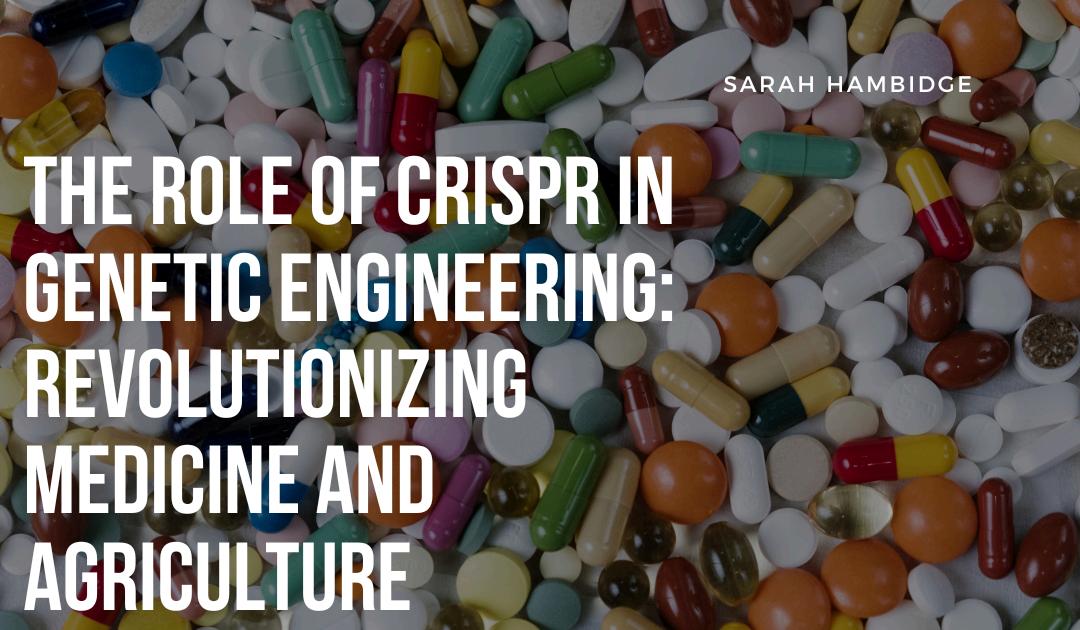The Role of CRISPR in Genetic Engineering: Revolutionizing Medicine
and Agriculture

In recent years, CRISPR-Cas9 technology has taken the scientific world by storm, offering groundbreaking capabilities for gene editing. This tool, which can make precise modifications to DNA, holds the potential to revolutionize a wide range of fields, particularly medicine and agriculture. Understanding the mechanisms behind CRISPR, its current applications, and its ethical implications is essential for navigating this exciting and controversial technology
How CRISPR Works: A Scientific Breakthrough
At its core, CRISPR (Clustered Regularly Interspaced Short Palindromic Repeats) is a natural defense system used by bacteria to protect themselves from viral infections. The Cas9 protein (CRISPR-associated protein 9) acts as molecular scissors, cutting DNA at specific locations. Scientists have adapted this system for use in genetic engineering, creating an unprecedented level of precision in DNA editing. The process begins when a guide RNA directs the Cas9 protein to a targeted DNA sequence. Once there, the Cas9 protein cuts the DNA, allowing for the addition, removal, or modification of genetic material.
CRISPR has dramatically lowered the cost and time required to edit genes, making genetic research more accessible and effective. The simplicity and precision of CRISPR have made it one of the most important tools in modern genetics.
CRISPR in Medicine: Potential and Promise
In the medical field, CRISPR offers the potential to correct genetic mutations that cause a wide array of diseases. For instance, sickle cell anemia, a genetic disorder caused by a mutation in the hemoglobin gene, could be corrected by editing the gene in bone marrow stem cells. Clinical trials have already demonstrated success in this area, with patients showing signs of recovery following CRISPR-based treatments.
Another area where CRISPR shows great promise is in the treatment of genetic disorders like cystic fibrosis, Duchenne muscular dystrophy, and certain types of cancer By editing the genes responsible for these diseases, it may be possible to alleviate symptoms or even provide a cure. As research continues, scientists are also exploring the possibility of using CRISPR to target and eliminate cancer cells, offering new hope for those suffering from the disease. The ability to edit human embryos opens the door to potentially eradicating inherited diseases before birth. However, this capability also raises significant ethical concerns, particularly regarding the potential for “designer babies,” where genes could be selected or altered for desired traits. This topic remains highly controversial and is at the center of ongoing ethical debates in both scientific and public policy circles.
Agriculture: Enhancing Crops and Livestock
CRISPR technology has transformative applications in agriculture, where it is used to develop genetically modified crops and livestock with enhanced traits. One of the most exciting possibilities is the creation of drought-resistant crops, which could be vital in combating food insecurity caused by climate change. Crops like rice, wheat, and corn are being engineered to survive in arid conditions, making them more resilient to unpredictable weather patterns. In addition, CRISPR can be used to improve the nutritional profile of crops. For example, scientists are developing golden rice that is enriched with vitamin A, addressing global deficiencies in areas where rice is a staple food. Similarly, crops that are more resistant to diseases and pests could reduce the need for harmful pesticides, leading to more sustainable agricultural practices. Livestock breeding has also benefited from CRISPR. Scientists are working on creating disease-resistant animals and improving the overall health and productivity of livestock. For example, pigs could be engineered to resist diseases like PRRS (Porcine Reproductive and Respiratory Syndrome), which devastates swine populations globally.
Ethical Considerations and Future Implications
While the possibilities presented by CRISPR are exciting, the technology also raises profound ethical and moral questions. The most contentious issue involves germline editing, which refers to the alteration of genes in human embryos or reproductive cells. Unlike somatic cell editing (which affects only the individual), germline editing can pass on changes to future generations, potentially altering the genetic makeup of entire families and populations. Many ethicists warn that the ability to edit the human genome may lead to unintended consequences, such as creating inequalities based on genetic traits or even introducing harmful genetic changes that persist through generations. There is also the concern that gene patents could concentrate power in the hands of large corporations, limiting access to genetic therapies for those who need them most.
Internationally, countries are divided in their approach to regulating CRISPR technology. While some have moved to ban germline editing altogether, others are exploring frameworks that would allow for
its use under strict guidelines. The future of CRISPR, therefore, will be shaped not just by its scientific advancements but also by the ethical and political decisions made by governments and regulatory bodies.
A New Era of Genetics
CRISPR has the potential to dramatically alter the landscape of genetic science, from eradicating inherited diseases in humans to transforming agriculture and food production. However, as with all powerful technologies, its applications must be approached with caution and responsibility. Moving forward, ongoing research, ethical discussions, and regulatory frameworks will play a crucial role in ensuring that CRISPR is used for the greater good, with a careful eye toward its long-term effects on humanity and the environment.
